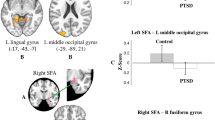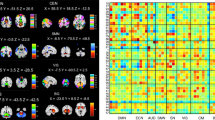Abstract
Patients with post-traumatic stress disorder (PTSD) exhibit exaggerated brain responses to emotionally negative stimuli. Identifying the neural correlates of emotion regulation in these subjects is important for elucidating the neural circuitry involved in emotional dysfunction. The aim of this study was to investigate the functional connectivity between the areas activated during emotional processing of negative stimuli in a sample of individuals affected by PTSD compared to a group of healthy subjects. Ten subjects with PTSD (who survived the L’Aquila 2009 earthquake) and ten healthy controls underwent fMRI during which the participants observed 80 images: 40 pictures with negative emotional valence and 40 neutral (scrambled) stimuli. A higher activation was found in the left posterior (LP) insula for PTSD group and in the ventromedial prefrontal cortex (vmPFC) for the healthy group. Two sets of Granger causality modeling analyses were performed to examine the directed influence from LP-insula and vmPFC to other brain regions. Activity in the vmPFC in the healthy group while observing negative stimuli predicted activity in several subcortical regions and insula, while in the PTSD group the LP-insula exerted a positive directed influence on several cortical regions. The hyperactivation in PTSD subjects of subcortical areas such as the insula would underlie the emotional, social, and relational difficulties of PTSD patients.


Similar content being viewed by others
References
Anderson MJ, Marwit SJ, Vandeberg B, Chibnall JT (2005) Psychological and religious coping strategies of mothers bereaved by the sudden death of a child. Death Stud 29:811–826
APA (2000) Diagnostic and statistical manual of mental disorders (4th ed., text revision). American Psychiatric Association, Washington, DC
Bandelow B, Koch M, Zimmermann P, Biesold KH, Wedekind D, Falkai P (2012) Post-traumatic stress disorder (PTSD) in the German Armed Forces: a retrospective study in inpatients of a German army hospital. Eur Arch Psychiatry Clin Neurosci 262:459–467
Beck JG, Grant DM, Clapp JD, Palyo SA (2009) Understanding the interpersonal impact of trauma: contributions of ptsd and depression. J Anxiety Disord 23:443–450
Bernhardt BC, Singer T (2012) The neural basis of empathy. Annu Rev Neurosci 35:1–2
Blake DD, Weathers FW, Nagy LM, Kaloupek DG, Gusman FD, Charney DS, Keane TM (1995) The development of a clinician-administered ptsd scale. J Trauma Stress 8:75–90
Brandley MM, Lang PJ (1994) Measuring emotion: the self-assessment manikin and the s mantic differential. J Behav Ther Exp Psy 25:49–59
Bryant RA, Creamer M, O’Donnell M, Silove D, Clark CR, McFarlane AC (2009) Post traumatic amnesia and the nature of post-traumatic stress disorder after mild traumatic brain injury. J Int Neuropsychol Soc 15:862–867
Brooks J, Tracey I (2005) From nociception to pain perception: imaging the spinal and supraspinal pathways. J Anat 207:19–33
Catani C, Adenauer H, Keil J, Aichinger H, Neuner F (2009) Pattern of cortical activation during processing of aversive stimuli in traumatized survivors of war and torture. Eur Arch Psychiatry Clin Neurosci 259:340–351
Chapman E, Baron-Cohen S, Auyeung B, Knickmeyer R, Taylor K, Hackett G (2006) Fetal testosterone and empathy: evidence from the empathy quotient (eq) and the ‘‘reading the mind in the eyes’’ test. Soc Neurosci 1:135–148
Davidson JR, Book SW, Colket JT, Tupler LA, Roth S, David D, Hertzberg M, Mellman T, Beckmham JC, Smith RD, Davison RM, Katz R, Feldman ME (1997) Assessment of a new self-rating scale for post-traumatic stress disorder. Psychol Med 27:153–160
Decety J (2009) Empathy, sympathy and the perception of pain. Pain 145:365–366
Elliot TJ (2006) The cost of caring: an examination of the relationship between empathy, intelligence, and posttraumatic stress disorder in United States Army soldiers returning from Operation Iraqi Freedom. University of Denver, Denver
Etkin A, Wager TD (2007) Functional neuroimaging of anxiety: a meta-analysis of emotional processing in ptsd, social anxiety disorder, and specific phobia. Am J Psychiatry 164:1476–1488
Fonzo GA, Simmons AN, Thorp SR, Norman SB, Paulus MP, Stein MB (2010) Exaggerated and disconnected insular-amygdalar blood oxygenation level-dependent response to threat-related emotional faces in women with intimate-partner violence posttraumatic stress disorder. Biol Psychiatry 68:433–441
Forman SD, Cohen JD, Fitzgerald M, Eddy WF, Mintun MA, Noll DC (1995) Improved assessment of significant activation in functional magnetic resonance imaging (fmri): use of a cluster-size threshold. Magn Reson Med 33:636–647
Friston KJ, Holmes AP, Worsley KJ, Poline JP, Frith CD, Frackowiak RSJ (1995) Statistical parametric maps in functional imaging: a general linear approach. Hum Brain Mapp 2:189–210
Friston KJ, Williams S, Howard R, Frackowiak RSJ, Turner RJ (1996) Movement related effects in fmri time series. Magn Reson Med 35:346–355
Ganzel BL, Kim P, Glover GH, Temple E (2008) Resilience after 9/11: multimodal neuroimaging evidence for stress-related change in the healthy adult brain. NeuroImage 40:88–795
Goebel R, Roebroeck A, Kim DS, Formisano E (2003) Investigating directed cortical interactions in time-resolved fMRI data using vector auto regressive modeling and Granger causality mapping. Magn Reson Imaging 21:1251–1261
Han Y, Chung SJ, Kim J, Ahn K, Lee SI (2009) High sensitization rate to food allergens in breast fed infants with atopic dermatitis. Ann Allergy Asthma Immunol 103(4):332–336
Hopper JW, Frewen PA, van der Kolk BA, Lanius RA (2007) Neural correlates of reexperiencing, avoidance, and dissociation in PTSD: symptom dimensions and emotion dysregulation in responses to script-driven trauma imagery. J Trauma Stress 20(5):713–725
Kashdan TB, Elhai JD, Frueh BC (2006) Anhedonia and emotional numbing in combat veterans with PTSD. Behav Res Ther 44(3):457–467
Keightley ML, Winocur G, Graham SJ, Mayberg HS, Hevenor SJ, Grady CL (2003) An fMRI study investigating cognitive modulation of brain regions associated with emotional processing of visual stimuli. Neuropsychology 41(5):585–596
Koenigs M, Grafman J (2009) Posttraumatic stress disorder: the role of medial prefrontal cortex and amygdala. The Neuroscientist 15:540–548
Lang PJ (1980) Behavioral treatment and bio-behavioral assessment:computer applications. In: Sidowski JB, Johnson JH, Williams TA (eds) Technology in mental health and delivery systems. Ablex, Norwood, pp 119–137
Litz BT, Gray MJ (2002) Emotional numbing in posttraumatic stress disorder: current and future research directions. Aust N Z J Psychiatry 36:198–204
Lui S, Huang X, Chen L, Tang H, Zhang T, Li X, Li D, Kuang W, Chan RC, Mechelli A, Sweeey JA, Gong Q (2009) High-field MRI reveals an acute impact on brain function in survivors of the magnitude 8.0 earthquake in china. Proc Natl Acad Sci USA 106:15412–15417
Mazza M, Catalucci A, Mariano M, Pino MC, Tripaldi S, Roncone R, Gallucci M (2012) Neural correlates of automatic perceptual sensitivity to facial affect in posttraumatic stress disorder subjects who survived L’Aquila earthquake of April 6,2009. Brain Imaging Behav Feb 26. [Epub ahead of print]
Morey RA, Dolcos F, Petty CM, Cooper DA, Hayes JP, Labar KS, McCarthy G (2009) The role of trauma-related distractors on neural systems for working memory and emotion processing in posttraumatic stress disorder. J Psychiatr Res 43(8):809–817
Moroni L, Bettinardi O, Vidotto G, Balestroni G, Bruletti G, Giorgi I, Bertolotti G (2006) Anxiety and depression short scale: norms for its use in rehabilitation. Monaldi Arch Chest Dis 66(4):255–263
Muller JL, Sommer M, Wagner V, Lange K, Taschler H, Roder CH, Schuierer G, Klein HE, Hajak G (2003) Abnormalities in emotion processing within cortical and subcortical regions in criminal psychopaths: evidence from a functional magnetic resonance imaging study using pictures with emotional content. Biol Psychiatry 54:152–162
Nietlisbach G, Maercker A, Rossler W, Haker H (2010) Are empathic abilities impaired in posttraumatic stress disorder? Psychol Rep 106:832–844
Price DD (2000) Psychological and neural mechanisms of the affective dimension of pain. Science 288:1769–1772
Rainville P, Carrier B, Hofbauer RK, Bushnell MC, Duncan GH (1999) Dissociation of pain sensory and affective dimensions using hypnotic modulation. Pain 82:159–171
Rainville P, Bao QVH, Chrétien P (2005) Pain-related emotions modulate experimental pain perception and autonomic responses. Pain 118:306–318
Rauch SA, Shin LM, Phelps E (2006) Neurocircuitry models of posttraumatic stress disorder and extinction: human neuroimaging research—past, present, and future. Biol Psychiatr 60:376–382
Roebroeck A, Formisano E, Goebel R (2005) Mapping directed influence over the brain using Granger causality and fMRI. Neuroimage 25:230–242
Salomons TV, Osternman JE, Gagliese L, Katz J (2004) Pain flashbacks in posttraumatic stress disorder. Clin J Pain 20:83–87
Shin LM, Orr SP, Carson MA, Rauch SL, Macklin ML, Lasko NB, Peters PM, Metzger LJ, Dougherty DD, Cannistraro PA, Alpert NM, Fischman AJ, Pitman RK (2004) Regional cerebral blood flow in the amygdala and medial prefrontal cortex during traumatic imagery in male and female Vietnam veterans with ptsd. Arch Gen Psychiatry 61:168–176
Shin LM, Liberzon I (2010) The neurocircuitry of fear, stress, and anxiety disorders. Neuropsychopharmacology 35:169–191
Spielberger CD, Vagg PR (1984) Psychometric properties of the STAI: a reply to ramanaiah, franzen, and schill. J Pers Assess 48:95–97
Steiner H, Saxena KS, Carrion V, Khanzode LA, Silvermann M, Chang K (2007) Divalproex sodium for the treatment of ptsd and conduct disordered youth: a pilot randomized controlled clinical trial. Child Psychiatry Hum Dev 38:183–193
Talairach J, Tournoux P (1988) Co-planar stereotaxic atlas of the human brain. Thieme Medical Publishers, Inc., New York
van der Kolk BA, Hostetler A, Herron N, Fisler RE (1994) Trauma and the development of borderline personality disorder. Psychiatr Clin North Am 17:715–730
Vidotto G, Moroni L, Burro R, Filipponi L, Balestroni G, Bettinardi O, Bruletti G, Giorgi I, Naimo M, Bertolotti G (2010) A revised short version of the depression questionnaire. Eur J Cardiovasc Prev Rehabil 17:187–197
Acknowledgments
This research has been partially supported by a grant of the “Fondazione Cassa di Risparmio della Provincia dell’Aquila” (CARISPAQ 2011) to Michele Ferrara.
Conflict of interest
None.
Author information
Authors and Affiliations
Corresponding author
Rights and permissions
About this article
Cite this article
Mazza, M., Tempesta, D., Pino, M.C. et al. Regional cerebral changes and functional connectivity during the observation of negative emotional stimuli in subjects with post-traumatic stress disorder. Eur Arch Psychiatry Clin Neurosci 263, 575–583 (2013). https://doi.org/10.1007/s00406-013-0394-3
Received:
Accepted:
Published:
Issue Date:
DOI: https://doi.org/10.1007/s00406-013-0394-3




